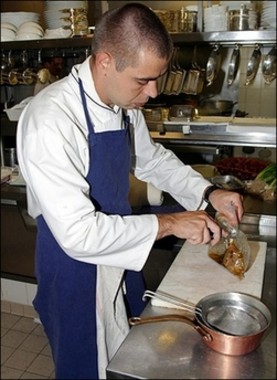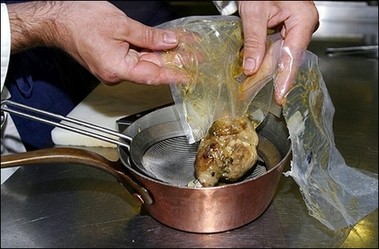Secret’s out on tasty French art of ‘vac-pac’ cooking
October 16, 2006 - Agence France Presse

PARIS (AFP) - At first glance, it is reminiscent of war-time rations or TV dinners. Perhaps that’s why this French-invented culinary trend has taken 30 years to catch on here.
‘Sous vide’, French for ‘under vacuum’, and also known as vac-pac or Cryovack cooking, is a technique where food is vacuum packed in a special plastic bag then slow cooked at low temperatures.
Compared to the traditional hustle-bustle found in kitchens with their usual multitude of quick-cooking saute pans, sous vide might be the least flashy method of cooking around.
But it can also produce extraordinary results.
“The texture is not the same with traditional methods of cooking,” chef Pierre-Dominique Cecillion said, drawing a cross section of lamb with concentric circles inside of it.
“At 220 degrees (a more traditional cooking temperature), the collagen on the outside crisps up and creates a barrier to heating the inside,” he explained, adding this left only a tiny circle in the middle at the desired doneness.
“With sous vide, the color is even throughout.”
 A sous-chef at Michelin three-star restaurant Pierre Gagnaire, removes pheasant with a pistachio stuffing from the vacuum-sealed bag in which it was slow-cooked at a very low temperature in Paris.(AFP/Joe Ray)
A sous-chef at Michelin three-star restaurant Pierre Gagnaire, removes pheasant with a pistachio stuffing from the vacuum-sealed bag in which it was slow-cooked at a very low temperature in Paris.(AFP/Joe Ray)The birth of sous vide cooking is attributed to a 1974 collaboration between French chefs Georges Pralus and Pierre Troisgros who wanted to develop a technique to keep foie gras from losing precious and expensive weight when it was being cooked.
Chef Jean-Pierre Kausz, another fan of sous vide, gestured around the kitchen at his restaurant, Chez Antoine, in the town of Les Ulmes in France’s central Loire Valley region, which had fewer flashing pans than most.
“It’s less sexy,” he acknowledged, “but more comfortable.”
So it is surprising that until recently sous vide only tended to be used by either three-star chefs, who apparently kept it a secret, or industrial food-makers, who wanted to push back their products’ expiration dates.
But the technique is now becoming more mainstream, making its way down to smaller restaurants, such as the one in the Loire Valley, and some chefs say they imagine home cooks using it soon.
“Vacuum packing and low-temperature cooking are two separate processes,” highlighted molecular gastronomist, Herve This, a French government scientist.
Most chefs however lump the processes together under one name.
Vacuum packing is a very effective means of product conservation. Throw meat in a bag, suck out the air, cool it properly and it will keep for a relatively long time.
But add herbs or other marinating items to the bag and they are amazingly effective at enhancing flavour, with some chefs saying it multiplies their potency by 10.
Molecular gastronomist This drew a diagram representing a piece of meat.
“Cook something at a high temperature and this is what happens,” he said, lopping off a quarter of the diagram. “That 25 percent is what gets cooked off whether you saute it or boil it in water.”
There is a lot of flavor in those lost juices, and a lot of money.
This collaborates with Michelin three-star chef and sous vide convert Pierre Gagnaire, whose work with This led him to design his restaurant’s web site with a molecular theme, and the two regularly work together to create dishes.
The challenge is to find the temperatures that work best between 60 and 100 degrees, and this is where science and the art of the kitchen collide.
There is also a matter of personal taste.
“My wife doesn’t like lamb at 65 degrees, but I love it,” said This.
For years, Cecillion was one of sous vide’s biggest proponents at his Parisian restaurant Le Jardin des Cygnes.
Now running the Academie Cinq Sens cooking school in Paris’ well-off eighth arrondissement, Cecillion continues to sing the method’s praises, not least because it can do wonders for tough cuts of meat.
“We cook a beef paleron (a notoriously chewy cut) for 72 hours at 68 degrees and the inedible nerve that runs down the middle of the cut disappears,” Cecillion said.
He is grateful for the science that allows this to happen.
“People don’t want to understand the mechanics of sous vide,” he said, “but we (chefs) respect the molecules.”
Chef Kausz certainly respects the molecules. “Unless you’re trying to, sous vide makes it impossible to screw up a duck breast,” he said.
Sous vide is also slowly making its way into home cooking. Cecillion excitedly pulled out a brochure for a low-temperature home oven which he had found at a trade show.
“I’m hoping people will start sous vide cooking in their homes in the next five years.”
THIS STORY ALSO RAN WITH: Sawf News, The Tocqueville Connection, Yahoo News.